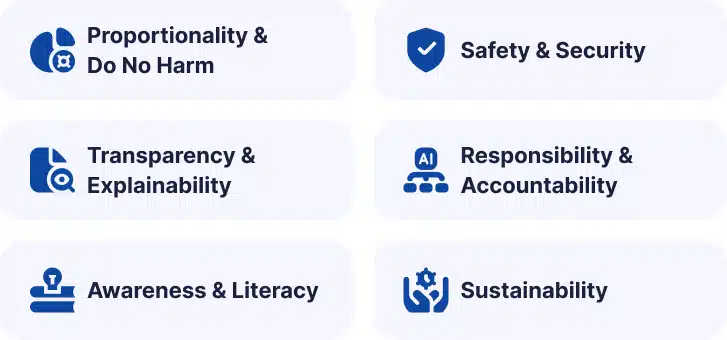- The Current Landscape: Adoption, Investment, and ROI Reality
- Key Drivers Fueling Generative AI’s Growth in 2025
- 1. Technical Breakthroughs with Multimodal AI</a/>
- 2. Mature AI-Native Cloud Infrastructure
- 3. Growing Demand for Hyper-Personalized Experiences
- 4. Faster Innovation Cycles
- Strategic Use Cases Delivering Measurable Business Value
- Scaling from Pilots to Enterprise-Wide Platforms
- Common Challenges in Generative AI Adoption and How to Overcome Them
- Technical and Architectural Imperatives to Future-Proof AI Investments
- Governance, Ethics, and Environmental Responsibility
- Leadership, Talent Development, and Cultural Transformation
- Emerging Trends to Watch in Generative AI
- Lead the AI Transformation Now!
We all saw that in last couple of years, generative AI has made the leap from being a futuristic buzzword to a must-have topic in boardrooms across industries.
What began as exciting experiments with chatbots, content generators, and AI art tools has matured into a powerful business tool. Now, generative AI is part of the core strategy for companies ranging from banking and healthcare to retail and manufacturing
But one thing: many organizations are still stuck in a cycle of isolated pilot projects and proofs-of-concept that never translate into real, measurable business value. The real challenge for business leaders today isn’t simply adopting AI, but turning that adoption into lasting impact, whether through cost savings, better customer experiences, faster innovation, or new revenue streams.
This article takes a practical look at how leaders can move beyond the initial excitement to build generative AI into a driver of sustainable growth.
We’ll cover where the technology stands today, high-value use cases, common challenges, and what it takes to scale AI responsibly across the enterprise.
The Current Landscape: Adoption, Investment, and ROI Reality
The pace of generative AI adoption over the past two years has been nothing short of remarkable. Surveys show that enterprise usage has jumped from around 33% to nearly 78%, with more than 80% of organizations planning to deploy generative AI solutions by 2026. This rapid uptake signals a broad recognition that AI is no longer just an experiment but a key business enabler.
Investment trends back this up. In 2024, private funding in generative AI companies hit approximately $34 billion worldwide – a nearly 19% increase from the previous year. This surge is driving innovation not only at large tech firms but also at startups specializing in domain-specific AI applications.
Despite the excitement and money flowing in, the reality of realizing AI’s business value is more complex. Studies reveal that only about 25% of AI projects meet their original expectations, and just 16% successfully scale beyond pilot stages across the enterprise. Barriers like fragmented governance, poor data quality, skills shortages, and misalignment with core business goals are common stumbling blocks.
For business leaders, this means moving beyond the hype requires a clear-eyed view of these challenges. It’s about building solid foundations and setting realistic expectations laying the groundwork to shift AI from promising pilots into strategic assets that deliver measurable impact.
Key Drivers Fueling Generative AI’s Growth
What’s pushing generative AI beyond hype and into practical, everyday use? Several key factors are converging:
1. Technical Breakthroughs with Multimodal AI
AI systems nowadays don’t just process text; they understand images, video, and audio together. This multimodal capability brings new possibilities, such as AI-powered customer support bots that can see product photos while answering queries, or content creation tools that combine written articles with custom graphics automatically. Additionally, domain-specific AI models fine-tuned on industry data improve accuracy and relevance, making AI smarter and more trustworthy.
2. Mature AI-Native Cloud Infrastructure
Cloud platforms have evolved to be AI-ready environments where businesses can deploy, test, and scale AI models quickly without huge upfront hardware investments. This shift means enterprises can experiment faster and iterate more efficiently, lowering the barrier to entry.
3. Growing Demand for Hyper-Personalized Experiences
Customers today expect brands to know their preferences and tailor experiences accordingly. Generative AI enables companies to deliver personalized marketing, product recommendations, and services at scale something manual processes cannot match. This hyper-personalization drives engagement, loyalty, and ultimately revenue growth.
4. Faster Innovation Cycles
Automating routine content generation, rapid prototyping, and compliance documentation accelerates development timelines. What once took weeks or months can now happen in days, giving companies a competitive edge in speed-to-market.
Together, these drivers are turning generative AI from a buzzword into a practical, strategic business tool across industries.
Strategic Use Cases Delivering Measurable Business Value
To justify investment and gain organizational buy-in, business leaders should prioritize use cases that demonstrate clear ROI. Here are some powerful examples:
Customer Service Automation
Klarna, a fintech giant, has automated approximately 85% of customer inquiries with AI-powered chatbots. This drastically reduces response times and operational costs, while improving customer satisfaction by providing instant, 24/7 support.
Accelerating Software Engineering
Companies like Adidas and Moderna are using generative AI to speed up engineering workflows. Moderna, for example, deploys over 700 customized GPT models to assist drug discovery and automate documentation, shortening innovation cycles and reducing human error.
Cross-Industry Operational Gains
Financial institutions such as JPMorgan employ AI to detect fraud more effectively. Retailers like Walmart optimize logistics with intelligent automation, cutting costs and improving supply chain efficiency. Healthcare providers automate claims processing to reduce errors and turnaround times. These applications translate into significant bottom-line impact.
Content and Design Automation
Beyond marketing, AI helps create compliance reports, regulatory filings, and design prototypes automatically. This reduces manual effort, speeds up processes, and minimizes costly mistakes.
These use cases show that generative AI is versatile touching multiple functions and unlocking value throughout the enterprise.
Scaling from Pilots to Enterprise-Wide Platforms
Moving beyond successful pilots to large-scale AI deployments requires deliberate strategy:
Governance and Risk Management
Robust frameworks are essential to ensure AI compliance with regulations, mitigate biases, and maintain transparency. This builds trust internally and externally, critical for adoption.
Cross-Functional Teams
Bringing together data scientists, business analysts, IT architects, and domain experts ensures AI initiatives align with real business needs and technical realities.
Seamless Integration
Embedding AI capabilities within core systems like ERP, CRM, and supply chain platforms helps AI become part of everyday workflows rather than standalone tools.
Avoiding AI Sprawl
Uncoordinated AI tools lead to inefficiencies, security risks, and governance gaps. Centralized oversight and strategic planning prevent this common pitfall.
Organizations that adopt a holistic approach stand a better chance of sustaining AI benefits at scale.
Common Challenges in Generative AI Adoption and How to Overcome Them
Even with the best intentions, many organizations encounter significant challenges when implementing generative AI initiatives. Understanding these barriers early can help business leaders take proactive steps to ensure success:
- Change Management Resistance: One of the biggest hurdles is human. Employees may resist adopting AI tools due to fear of job loss, lack of understanding, or discomfort with new technology. This resistance can slow or stall AI integration. To overcome it, organizations should involve users early, communicate transparently about AI’s role, and provide ongoing training. Building champions within teams and celebrating early wins fosters acceptance and momentum.
- Data Quality and Availability: AI models require vast amounts of high-quality, clean, and relevant data. Poor data quality like incomplete, outdated, or inconsistent data can lead to inaccurate or biased AI outputs, eroding trust and reducing ROI. Establishing strong data governance policies, investing in data cleansing tools, and ensuring data is accessible across departments are critical foundations for effective AI.
- Vendor Lock-In Risks: Many organizations start AI projects relying heavily on specific vendors’ proprietary platforms. While this can speed initial deployment, over-reliance creates risks around cost, flexibility, and innovation. To mitigate this, companies should invest in developing internal AI expertise, embrace open standards, and build modular AI architectures that allow swapping or combining different tools to best fit evolving needs.
By anticipating these issues and planning mitigation strategies upfront, companies greatly improve their chances of moving AI projects beyond pilot phases and into scalable, impactful solutions.
Technical and Architectural Imperatives to Future-Proof AI Investments
As generative AI evolves rapidly, enterprises must design technical architectures that are flexible, secure, and scalable to sustain long-term benefits:
- Composable AI Architectures: Rather than building responsible AI solutions, composable architectures allow integration of multi-agent Gen AI components, such as natural language processing, image recognition, and recommendation engines into cohesive workflows. This modularity enables businesses to quickly adapt to new tools, avoid vendor lock-in, and continuously innovate without large overhauls.
- Edge AI Deployment: For applications demanding real-time processing or enhanced privacy like manufacturing robots, autonomous vehicles, or healthcare monitoring processing AI tasks on edge devices (near the data source) minimizes latency and limits sensitive data exposure. Edge AI complements cloud-based models, offering a hybrid solution tailored to diverse operational needs.
- Agentic AI Workflows: The next frontier in generative AI involves autonomous agents that can independently execute complex tasks, ranging from troubleshooting IT issues before they escalate to managing dynamic supply chains in real-time. Deploying these requires updated API designs, strong monitoring, and safeguards to ensure reliability and prevent unintended consequences.
Investing in these forward-thinking technologies now prepares enterprises to scale AI responsibly and maintain competitive advantage as capabilities expand.
Governance, Ethics, and Environmental Responsibility

AI governance is no longer just a technical checkbox but a critical element shaping trust, compliance, and sustainability:
- Data Sovereignty and Regulatory Compliance: Organizations must keep control over sensitive data and comply with increasingly complex regional regulations such as GDPR, CCPA, or sector-specific rules. Transparent policies on data usage and retention build stakeholder confidence and reduce legal risk.
- Explainability and Accountability: To ensure AI-driven decisions are fair and auditable, companies need mechanisms to trace how models reach conclusions. Explainability tools help demystify AI outputs for users and regulators alike, enabling quicker issue resolution and fostering trust.
- Environmental Impact and Sustainability: Training and running large AI models consume energy, contributing to carbon emissions. Incorporating sustainability metrics into AI governance—such as optimizing model efficiency, using renewable energy sources, or offsetting emissions—is essential for responsible innovation aligned with corporate social responsibility goals.
Leaders who embed ethical principles and sustainability into their AI strategy position their organizations for long-term success and positive societal impact.
Leadership, Talent Development, and Cultural Transformation
Successful generative AI adoption depends as much on people and culture as on technology:
- Strategic Leadership Commitment: AI leaders increasingly report directly to CEOs, highlighting AI’s growing importance in corporate strategy. This top-level support drives resource allocation and cross-functional collaboration needed to scale AI.
- Building Workforce AI Fluency: Employees across roles often have higher AI readiness than anticipated. Investing in broad-based upskilling initiatives covering AI literacy, tool usage, and ethical considerations empowers teams to embrace AI as an enabler rather than a threat.
- Evolving Job Roles and Satisfaction: AI automates routine, repetitive tasks, freeing knowledge workers and creatives to focus on complex, strategic, or creative endeavors. This shift often enhances job satisfaction, drives innovation, and can lead to improved compensation and career growth.
Adapting to a culture that encourages experimentation, learning from failures, and collaboration across data scientists, business units, and IT unlocks the full power of generative AI.
Emerging Trends to Watch in Generative AI
To stay competitive, business leaders should monitor these rapidly developing trends:
- Agentic AI Agents: Autonomous AI systems embedded in business processes will proactively manage tasks—such as predictive maintenance, IT incident resolution, or supply chain adjustments—reducing downtime and increasing efficiency.
- Multimodal Generative AI: AI models that integrate text, images, video, and audio generation offer richer content creation and customer engagement capabilities, enabling immersive marketing campaigns, realistic training simulations, and accessible communications.
- Generative Engine Optimization (GEO): This emerging discipline optimizes AI-powered content discovery and digital presence, reshaping how businesses improve online visibility and customer targeting beyond traditional SEO strategies.
Businesses that adapt early to these innovations can avail new revenue streams and maintain competitive advantages in an AI-driven market.
Practical Roadmap: From Pilot to Enterprise-Wide Impact

To convert generative AI from promising experiments into sustained business value, leaders should:
- Identify Business-Aligned, Measurable Use Cases: Prioritize projects with clear KPIs like cost reduction, revenue growth, or customer satisfaction, rather than exploratory pilots without defined impact.
- Implement Rigorous Measurement Frameworks: Track operational metrics like task completion speed, accuracy improvements, and financial returns to assess and communicate AI benefits.
- Establish Ethical and Risk Governance: Develop continuous monitoring systems to detect bias, ensure fairness, and maintain compliance with regulatory standards.
- Invest in Talent Development: Build cross-functional AI teams and reskill employees through targeted training programs, fostering broad organizational fluency.
- Adopt Flexible Hybrid Architectures: Combine cloud, edge, and composable AI platforms to maintain agility and accommodate evolving technology needs.
- Scale Responsibly: Balance ambition with data readiness, ROI focus, and sustainability priorities to deliver lasting value.
This disciplined, people-centric approach turns AI initiatives into competitive differentiators.
Lead the AI Transformation Now!
Generative AI is a powerful business enabler but only when integrated thoughtfully with strategy, technology, governance, and culture. The organizations that succeed will combine visionary leadership with operational discipline and measurable accountability.
Business leaders must move beyond hype and isolated pilots to embed AI deeply and responsibly across their enterprise. Doing so gets you unprecedented operational efficiency, hyper-personalized customer experiences, and sustainable competitive advantage.
Helius Work is passionate about helping business leaders unlock the potential of generative AI providing the right tools, insights, and support to turn your vision into reality.



